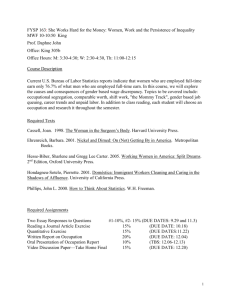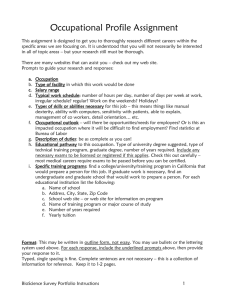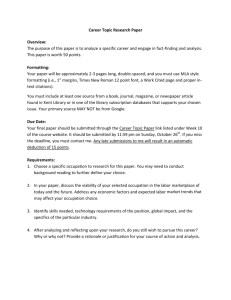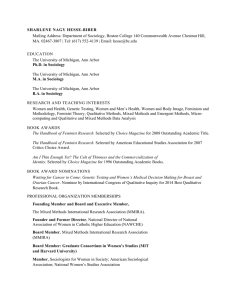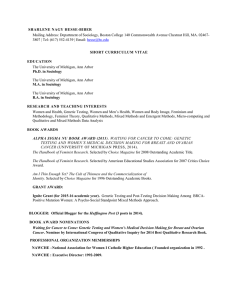FYSP 163 - Oberlin College
advertisement
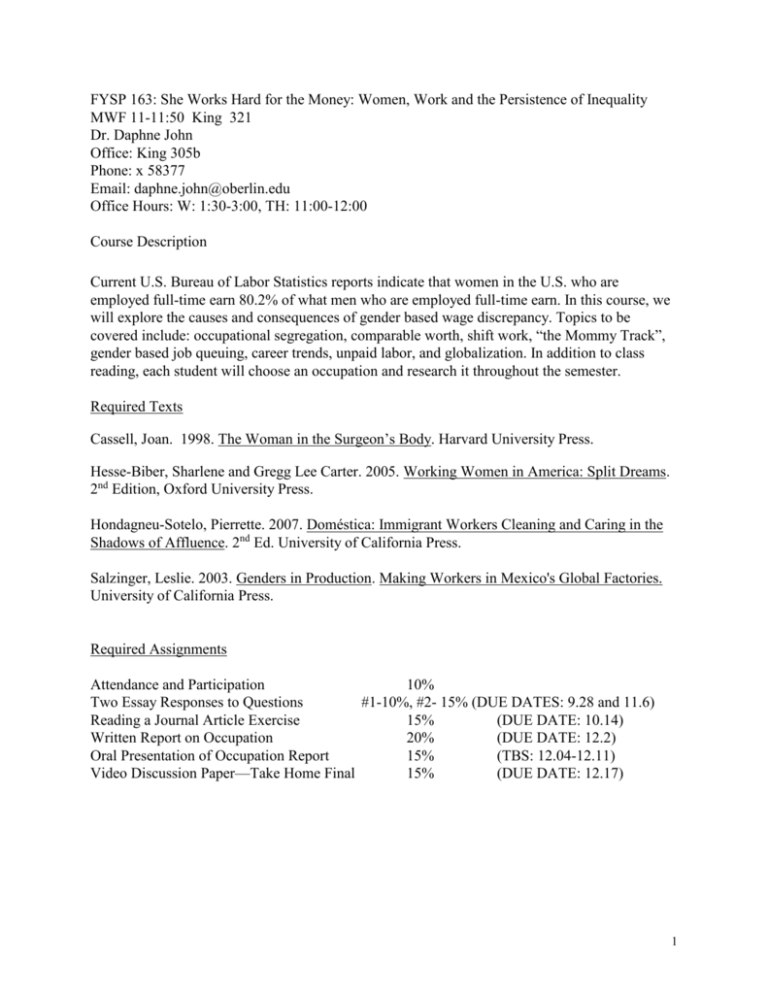
FYSP 163: She Works Hard for the Money: Women, Work and the Persistence of Inequality MWF 11-11:50 King 321 Dr. Daphne John Office: King 305b Phone: x 58377 Email: daphne.john@oberlin.edu Office Hours: W: 1:30-3:00, TH: 11:00-12:00 Course Description Current U.S. Bureau of Labor Statistics reports indicate that women in the U.S. who are employed full-time earn 80.2% of what men who are employed full-time earn. In this course, we will explore the causes and consequences of gender based wage discrepancy. Topics to be covered include: occupational segregation, comparable worth, shift work, “the Mommy Track”, gender based job queuing, career trends, unpaid labor, and globalization. In addition to class reading, each student will choose an occupation and research it throughout the semester. Required Texts Cassell, Joan. 1998. The Woman in the Surgeon’s Body. Harvard University Press. Hesse-Biber, Sharlene and Gregg Lee Carter. 2005. Working Women in America: Split Dreams. 2nd Edition, Oxford University Press. Hondagneu-Sotelo, Pierrette. 2007. Doméstica: Immigrant Workers Cleaning and Caring in the Shadows of Affluence. 2nd Ed. University of California Press. Salzinger, Leslie. 2003. Genders in Production. Making Workers in Mexico's Global Factories. University of California Press. Required Assignments Attendance and Participation 10% Two Essay Responses to Questions #1-10%, #2- 15% (DUE DATES: 9.28 and 11.6) Reading a Journal Article Exercise 15% (DUE DATE: 10.14) Written Report on Occupation 20% (DUE DATE: 12.2) Oral Presentation of Occupation Report 15% (TBS: 12.04-12.11) Video Discussion Paper—Take Home Final 15% (DUE DATE: 12.17) 1 Instructor policies (1) Class Attendance and Participation: It is your commitment to this class and your classmates that you will be present and ready to begin work at the start of class. Participation includes inclass group work, engagement in response to instructor queries and active listening. The instructor will occasionally ask students to be responsible for particular readings and be able to discuss the material with the class. Repeated lateness may result in significant deductions to your final grade in this course. After two absences, additional absences will generally lower your final grade in the course (1/3 of a grade per two additional absences). In case of illness or personal emergency, absences may be excused through a doctor or dean’s note. (2) Assignments are due IN CLASS the day they are due. An extension will be automatically applied to all assignments until 4:30 the day they are due. After this grace period, 1/3 of a letter grade (e.g. an A would be reduced to an A-) will be deducted for each day of lateness, unless you have previously made arrangements with the instructor because of illness or emergency. I prefer assignments to be handed in on paper (double sided is fine), but will accept assignments via the Digital Drop Box on the course Blackboard site. NOTE: Any material placed in the Digital Drop Box MUST be formatted as an MS Word file or in Rich Text Format. Regardless of whether you hand papers in as digital or physical—please retain a copy of this work for yourself. Please use the Times New Roman 12pt font or an equivalent. (3) Office Hours are listed at the top of this syllabus. If you would like to meet at a specific time during my office hours, please sign up on the sheet next to my office door. You may also drop in if no one has signed up for the time. Upon special request, I will meet with students at times outside of my office hours. Please see me IN PERSON to set up such an appointment. (4) I receive up to 30 or more e-mails per day. Please do not expect me to reply immediately to an e-mail question or request. If something is urgent, please CALL ME in my office or signify in the e-mail header that it is urgent. (5) In order to receive QPh credit you must average a B- or better on the quantitative assignments. (6) Honor Code: This course will follow the policies described in the Oberlin College Honor Code and Honor System. Please include the statement “I affirm that I have adhered to the Honor Code in this assignment” in all written work. Please contact me if you have any questions about citation, or the relationship of the Honor Code to your work in this course. For more information on the Honor Code, see http://www.oberlin.edu/students/student_pages/honor_code.html. (7) Students with Disabilities: If you need disability-related accommodations for your work in this course, please let me know. Support is available through Student Academic Services— please contact Jane Boomer, Coordinator Office of Disability Services, (Room G27/28 Peters Hall, ext. 55588, http://www.oberlin.edu/disability) for assistance in developing a plan to address your academic needs. 2 (8) The instructor reserves the right to modify the syllabus during the semester, if needed. Description of Assignments Essays: Students will be given a choice of essay questions, from which they will select one to answer, approximately one week before the due date. The answers should reference as much of the reading as possible to support the answers. A bibliography should be attached. Each essay should be approximately 4-5 pages and double-spaced. Journal Article Exercise: Students will be given an empirically based article to read from a scholarly journal. Specific questions will be asked regarding the content and structure of the article as well as interpretation of statistical findings. Occupation Report: Each student will select an occupation (or occupational category) to examine. The research should address the following: What is the history of this occupation? What is the nature of the work in this occupation? Is this occupation considered to be male-dominated, female-dominated or gender balanced? Is gender and/or racial segregation present within the occupation by job category? What are the requirements for employment in this occupation and how do those requirements vary by job category? What sectors of the labor market are the jobs in this occupation in? What are the experiences of women in this occupation? What are the typical wages and benefits of the jobs in this occupation? Is there job growth or decline in this occupational area? What are the positive and negative aspects of employment for women in this area? (A variety of resources (eg. books, journal articles, The Occupational Outlook Handbook, TheMonthly Labor Review, Statistical Abstracts of the United States) should be utilized when gathering information.) The in-class PowerPoint presentation (during the last week of class) will consist of highlights from the research. Each presentation will be 15 minutes in length. Student will receive instruction on the use of PowerPoint. The written component will be in the form of a 10 page paper reviewing the literature and empirical studies in regard to the questions above. A bibliography must be included with the paper. This assignment serves as the final exam for the course. Video Discussion Paper—Take Home Final: Students will be asked to respond to several essay questions based on the films we will watch (and some that will be on reserve for viewing) during the semester. These essays will focus on comparison of particular themes in the documentaries as well as links to the semester readings. The exam is open book/open note. 3 Learning Objectives: 1. To enable students to place women’s labor related issues within historical and social contexts. 2. To understand and apply key concepts including the social construction of gender, labor and work, theories of inequality and stratification, and globalization. 3. To investigate the relationship between work/labor and gender from an intersectional framework. 4. To equip students to manage and analyze information from a social science perspective. 5. To develop critical analytic skills through discussion, writing and oral presentation. Course Outline 8.31-9.9 I. Introduction/History Hesse-Biber and Carter: Preface, Chapter 1: Models of Women and Work, Chapter 2: A Brief History of Working Women On Blackboard Amott and Matthaei: Race, Class, and Gender and Women’s Work Edwards: Contested Terrain Hall: Gender and Work Ortiz: Puerto Rican Women in the Garment Industry of New York City, 1920-1980 Dublin: Lowell Millhands, Lynn Shoeworkers, Working Women in New England, 1900 Borden: Maybe I should Forget the Union and the Factory Brush: Gender, Work, Who Cares?! Production, Reproduction, Deindustrialization and Business as Usual Thistle: The New Economy and the Transformation of Women’s Work Sayer: Gender, Time and Inequality VIDEO: The Life and Times of Rosie the Riveter The Phantom of the Operator The Trickle Down Theory of Sorrow 4 9.11-9.18 II. Indicators and Explanations of Inequality Hesse-Biber and Carter: Chapter 3: Gender Inequality: Economic and Legal Explanations On Blackboard Marx: Alienated Labor Durkheim: The Social and Political Role of Occupational Groups Weber: Bureaucracy Federal Glass Ceiling Commission: The Glass Ceiling Tomaskovic-Devey: Sex and Racial Segregation and Pay Gaps Ferdman: The Color and Culture of Gender in Organizations England, Thompson and Aman: The Sex Gap in Pay and Comparable Worth: An Update Hossfield: The Logic Against Them Reskin and Roos: Occupational Sex Segregation: Persistence and Change, Queueing and Changing Occupational Composition, Consequences of Desegregation: Occupational Integration and Economic Equity? Elliot: Comparing Occupational Segregation in Great Britain and the United States: The Benefits of Using a Multi-Group Measure of Segregation 9.21-9.25 III. Work, Racial and Ethnic Inequalities, and Socialization Hesse-Biber and Carter: Chapter 4: Gender Inequality and Socialization: The Influences of Family, School, Peers and the Media On Blackboard Freeman: Parental Influence and Women’s Careers Hattery: Theoretical Paradigms for Understanding Maternal Labor Force Participation Helgeson: Women’s Ways of Leading Cintron-Velez: Generational Paths into and out of Work: Personal Narratives of Puerto Rican Women in New York Baker: Mexican-Origin Women in the Southwestern Labor Markets Stier: Immigrant Women Go to Work: Analysis of Immigrant Women’s Labor Supply for Six Asian Groups Loo and Ong: Slaying Demons with A Sewing Needle: Feminist Issues for Chinatown’s Women 5 England, Garcia-Beaulieu and Ross: Women’s Employment among Blacks, Whites and Three Groups of Latinas: Do More Privileged Women Have Higher Employment? 9.28 IV. Queer Experiences On Blackboard Dozier: Beards, Breasts and Bodies: Doing Sex in a Gendered World Griffith and Hebl: The Disclosure Dilemma for Gay Men and Lesbians: “Coming Out” at Work Myers, Forrest and Miller: Officer Friendly and the Tough Cop: Gays and Lesbians Navigate Homophobia and Policing. 9.30 V. Sexual Harassment On Blackboard Espinosa: Sexual Harassment Protection for Whom? Welsh, Carr, MacQuarrie and Huntley: I’m Not Thinking of it as Sexual Harassment: Understanding Harassment Across Race and Citizenship IV. Occupations, Professions and the Experience of Working 10.2 Hesse-Biber and Carter: Chapter 5: Women in Everyday Jobs: Clerical, Sales, Service and Blue-Collar Work On Blackboard Bronfenbrenner: Organizing Women: The Nature and Process of Union Organizing Efforts Among U.S. Women Since the mid-1990’s. VIDEO: The Wilmar 8 10.5-10.7 On Blackboard Casey: New Tappings on the Keys Garson: The Electronic Sweatshop Parker: Temporary Clerical Work 6 Connoley and Rhoton: Women in Direct Sales Hall: Waitering/Waitressing Paules: “Getting” and “Making” a Tip Reskin and Roos: Women Behind Bars Zhou and Nordquist: Work and Its Place in the Lives of Immigrant Women: Garment Workers in New York City’s Chinatown Juravich: Women on the Line Reskin and Roos: Hot-Metal to Electronic Composition Wang and Kleiner: Sex Discrimination in Fire Fighting Organisations VIDEO: Some Real Heat Hammering it Out North Country Waging a Living Clockwatchers 10.9-10.16 Hondagneu-Sotelo, Pierrette. 2007. Doméstica: Immigrant Workers Cleaning and Caring in the Shadows of Affluence. University of California Press. VIDEO: Maid in America Maid to Stay 10.26-11.2 Hesse-Biber: Chapter 6: Professional and Managerial Women On Blackboard Sokoloff: The Half-Full Glass, The Professions, White Women: Movement an Change, Black Women: Beyond the Myth of Double Advantage, The Half-Empty Glass: Can it Ever Be Filled? Higginbotham: Black Professional Women: Job Ceilings Rosenberg, Perlstadt and Phillips: “Now That We Are Here:” Discrimination, Disparagement and Harrassment at Work and the Experience of Women Lawyers Bird: An Analysis of Gender Differences in Income among Dentists, Physicians and Veterinarians, 1987 Glazer: “Between a Rock and a Hard Place”: Racial, Ethnic, and Class Inequalities in Women’s Professional Nursing Organizations Reskin and Roos: Industrial and Occupational Change in Pharmacy; A Woman’s 7 Place is Selling Homes; High Finance, Small Change Colwill: Women in Management: Power and Powerlessness Schwartz: Management Women and the New Facts of Life Reskin: Culture, Commerce, Gender VIDEO: Lifetime’s Women Docs (instructor copy) 11.4-11.11 Cassell, Joan. 1998. The Woman in the Surgeon’s Body. Harvard University Press. V. Work and Family 11.13-11.18 Hesse-Biber and Carter: Chapter 7: Working Women and Their Families On Blackboard Torruellas, Benmayor and Juarbe: Negotiating Gender, Work and Welfare: Familia as Productive labor among Puerto Rican Women in New York City Hattery: Balancing and Weaving to be a “Good” Mother, To Work or Not to Work? That is the Question, Are Children Better Off if they have New Bikes Rather than Having You at Home? Devault: Feeding the Family Shelton and John: The Division of Household Labor, Who Does What and How Much Do They Do? Gender and Total Work Time VIDEO: Juggling Work and Family VI. Social Change and the Global Economy 11.20 Hesse-Biber and Carter: Chapter 8: Changing the Lives of Working Women On Blackboard Moghdam: Gender and the Global Economy Hu-Dehart: Globalization and Its Discontents: Exposing the Underside Nash: Women in Between: Globalization and the New Enlightenment 8 11.23-11.30 Salzinger, Leslie. 2003. Genders in Production. Making Workers in Mexico's Global Factories. University of California Press. VIDEO: Maquilapolis Nalini by Day, Nancy by Night 12.2 North Country The Instructor reserves the right to modify this syllabus at any time during the semester. 9
